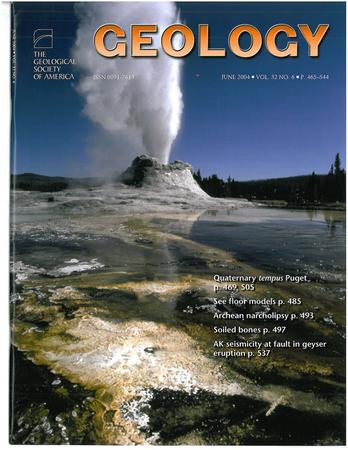全新世同震海相台地序列是完整的古地震记录吗?2016年7.8级Kaikōura地震期间形成的新海洋阶地的快速侵蚀表明并非如此!
IF 4.6
1区 地球科学
Q1 GEOLOGY
引用次数: 0
摘要
利用全新世同震海相台地重建地震震级和频率;然而,海岸侵蚀会使这些阶地消失,从而影响它们作为古地震记录的可靠性。全球阶地移动的速度是不受限制的,全新世同震海相阶地的飞行在多大程度上包含完整的古地震记录尚不清楚。2016年11月14日,新西兰发生7.8级(Mw) Kaikōura地震,导致潮间带海岸平台瞬间隆起0.8 - 1.0米,形成新的海洋阶地。自1974年以来,微侵蚀测量网络被用于确定这些海岸平台的侵蚀速率,提供了一个独特的机会来调查一个新的海洋平台被破坏的速度。抬升后,抬升率从2016年之前的0.944毫米/年增加到2.556毫米/年,增加了一倍多。使用以2.556毫米/年开始的线性衰减函数,新的海洋阶地将在552年内从景观中移除。当考虑到海平面上升和地震间沉降时,阶地可能仅在200年内被移除。~ 200 - 550年的时间窗口小于产生阶地的地震的返回时间,这表明在进一步的隆起确保保存之前,新的阶地可以从景观中被侵蚀。我们的发现阐明了全新世同震阶地序列如何呈现不完整的古地震活动记录,对重建构造活跃海岸的地震震级和频率具有重要意义。本文章由计算机程序翻译,如有差异,请以英文原文为准。
Are Holocene coseismic marine terrace sequences complete paleoseismic records? Rapid erosion of a new marine terrace created during the 2016 Mw 7.8 Kaikōura earthquake suggests not!
Holocene coseismic marine terraces are used to reconstruct earthquake magnitude and frequency; however, coastal erosion can remove these terraces, compromising their reliability as paleoseismic records. Rates of terrace removal globally are unconstrained, and the extent to which flights of Holocene coseismic marine terraces contain complete paleoseismic records is unclear. On 14 November 2016, the magnitude (Mw) 7.8 Kaikōura earthquake in New Zealand caused instantaneous uplift of 0.8−1.0 m of intertidal shore platforms, creating a new marine terrace. Since 1974, a micro-erosion meter network has been used to determine erosion rates of these shore platforms, providing a unique opportunity to investigate how quickly a new marine terrace is destroyed. Lowering rates more than doubled from 0.944 mm/yr prior to 2016 to 2.556 mm/yr following uplift. Using a linear decay function starting at 2.556 mm/yr the new marine terrace will be removed from the landscape in 552 yr. When sea-level rise and interseismic subsidence are considered, the terrace may be removed in only 200 yr. A time window of ∼200−550 yr is less than the return time of the earthquake that created the terrace, demonstrating that a new terrace can be eroded from the landscape before further uplift ensures preservation. Our findings clarify how Holocene coseismic terrace sequences present incomplete records of paleoseismicity, with significant implications for reconstructing earthquake magnitude and frequency on tectonically active coasts.
求助全文
通过发布文献求助,成功后即可免费获取论文全文。
去求助
来源期刊

Geology
地学-地质学
CiteScore
10.00
自引率
3.40%
发文量
228
审稿时长
6.2 months
期刊介绍:
Published since 1973, Geology features rapid publication of about 23 refereed short (four-page) papers each month. Articles cover all earth-science disciplines and include new investigations and provocative topics. Professional geologists and university-level students in the earth sciences use this widely read journal to keep up with scientific research trends. The online forum section facilitates author-reader dialog. Includes color and occasional large-format illustrations on oversized loose inserts.
 求助内容:
求助内容: 应助结果提醒方式:
应助结果提醒方式:


